Need Nickel? How Electrifying Transport and Chinese Investment Are Playing Out in the Indonesian Archipelago

Table of Contents
Author(s)
Michelle Michot Foss
Fellow in Energy, Minerals, and MaterialsJacob Koelsch
Research Associate, J.A. Green & Company; Former Research Intern, Center for Energy StudiesTo access the full paper, download the PDF on the left-hand sidebar. An executive summary is also available to download here.
Recent Context
Recent Context On March 8, 2022, the London Metals Exchange (LME) abruptly halted trading in nickel, which had reached a stunning $100,000 per tonne. As noted in many news sources, the LME events were a consequence of positions taken by Tsingshan Holding Group, which features prominently in our case study, based on expectations of falling prices. We allude to those expectations in our analysis of Tsingshan’s pursuit of nickel laterite deposits in Indonesia and their associated strategies for processing to obtain battery-grade material and building a battery metals value chain. Russia’s invasion of Ukraine and other recent developments, not least post-pandemic recovery, undermined Tsingshan’s short position, forcing the company to purchase nickel at increasing prices to cover their positions, and the LME to increase margin requirements for market participants. The extreme disruption in nickel trading and markets, while unusual, is an important signal for materials insecurities that lie ahead. The location of metals supplies, demographics of the mining and minerals processing industries, lack of depth in liquidity for metals markets and trading (with implications for credit quality and corporate and project financings), absence of open markets for many key minerals, and other shortcomings point to the extreme need for increased research, foresight, and oversight.
Introduction and Summary
The success of the global march toward “decarbonization” depends on the complicated logistics that support it, along with the convoluted strategies that form its underpinning. The process of shoring up supply chains is a prerequisite to sound strategic planning: Without robust supply chains, even the most elaborate blueprint for implementation will prove ostentatious in practice. The global push for electrification, as worthy a cause as it may be, is not immune to such realities. Indeed, the global push to electrify is creating new tensions and complexities that, if not properly managed and mitigated, will undermine the much-discussed “energy transition.” Emerging markets and developing countries are central to the “decarb” and electrification push, and are themselves maneuvering to attain advanced country status and a higher quality of life for their citizens. Minerals and the materials derived from them are at the heart of energy transition strategies, and emerging markets and developing economies are the overwhelming providers. The industrialized world brushes these realities under the rug in favor of self-aggrandizing agenda-setting, and, in doing so, engenders critical supply risks and the potential for further environmental degradation.
Widely ignored, although gaining attention, is China’s strategic positioning as a crucial gatekeeper to several key “green” technologies, including battery energy storage to support electric vehicles (EVs)—specifically, battery electric vehicles (BEVs)—along with stationary storage for power grids. China also dominates in other technologies including wind and solar components, controls, sensors, and communications—a gamut of industrial equipment, including much that is pertinent for defense. BEV designs have come to dominate the energy transition strategies of many governments along with those of large automakers and startups, since BEVs are regarded as providing the maximum reduction in tailpipe emissions. Having little of its own capacity for manufacturing traditional vehicles, and being a large (and growing) net importer of oil, natural gas, and petroleum products, China’s government and business elites have emphasized EV designs and production.
China’s powerful model of economic soft power has crept into commodity warehouses, EV factories, and everything in between, granting Chinese entities significant control over several links of these critical supply chains. In an era of unparalleled geopolitical friction, how China’s dominance will affect emissions reduction goals in places like the United States and Europe remains to be seen. Reports of human rights abuses in Xinjian and the political status of Hong Kong and Taiwan are key issues that close the door for cooperation with China on climate change. Thus, the success of EVs, much less anything else in the energy transition hopper, cannot be divorced from the geopolitics of the day. China’s inordinate influence over natural resource-producing and -exporting countries could translate to leverage in its revisionist power plays.
Accompanying the vigorous drive toward alternative energy technologies is the unavoidable pressure on the global supply of critical base metals. Nickel is no exception. In our report and case study we examine tensions in nickel supply and value chains within the context of broad aspirations to electrify transport.
Essential Information
Nickel is now deemed a critical mineral by the U.S. Geological Survey (USGS) mainly by virtue of assessed trade and economic vulnerabilities. Nickel is a key input for a host of industrial and consumer products and end uses, including the industry-standard cathode chemistry, NMC or lithium-nickel-manganese-cobalt-oxide (LiNiMnCoO2). The NMC 811, a nickel-rich cathode chemistry used by the auto industry, incorporates up to 80% nickel and 10% each of manganese and cobalt. It provides significant cost savings, improved energy density and efficiency, and a more sustainable balance of battery metallurgies in comparison to competing cathode chemistries. Nickel-rich cathodes have become more commonplace as EV manufacturers (original equipment manufacturers or OEMs) and their powertrain vendors increasingly migrate toward those chemistries. However, battery designs are intensely competitive and could prove disruptive, with implications for nickel producers and large resource owners like Indonesia.
Nickel production worldwide derives from two general occurrences: (1) laterites, chemically weathered igneous rock (which now accounts for about 60% of global nickel resources) where nickel associates with iron, and (2) magmatic sulfides (about 40%) where it associates with sulfur (Figure 1). Laterites are mined for nickel from tropical soils in Indonesia, the Philippines, New Caledonia, and elsewhere using surface extraction (Figure 2, top row). Sulfides are deeply occurring, requiring much more expensive extraction, including underground operations in places like Russia (Figure 2, bottom right).
Figure 1 — Global Distribution of Nickel Resources
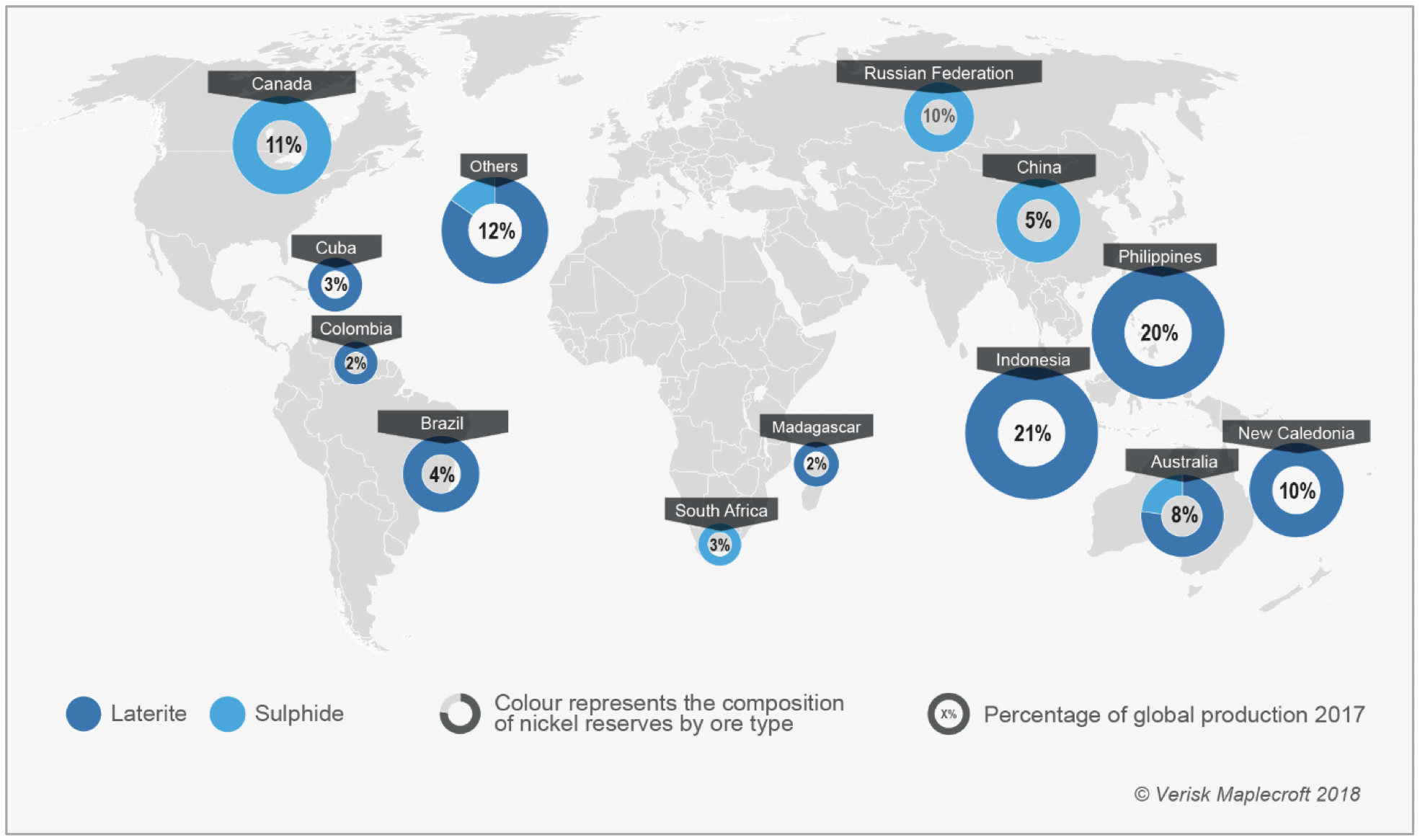
Figure 2 — Typical Laterite (Top) and Sulfide (Bottom) Nickel Mining Operations
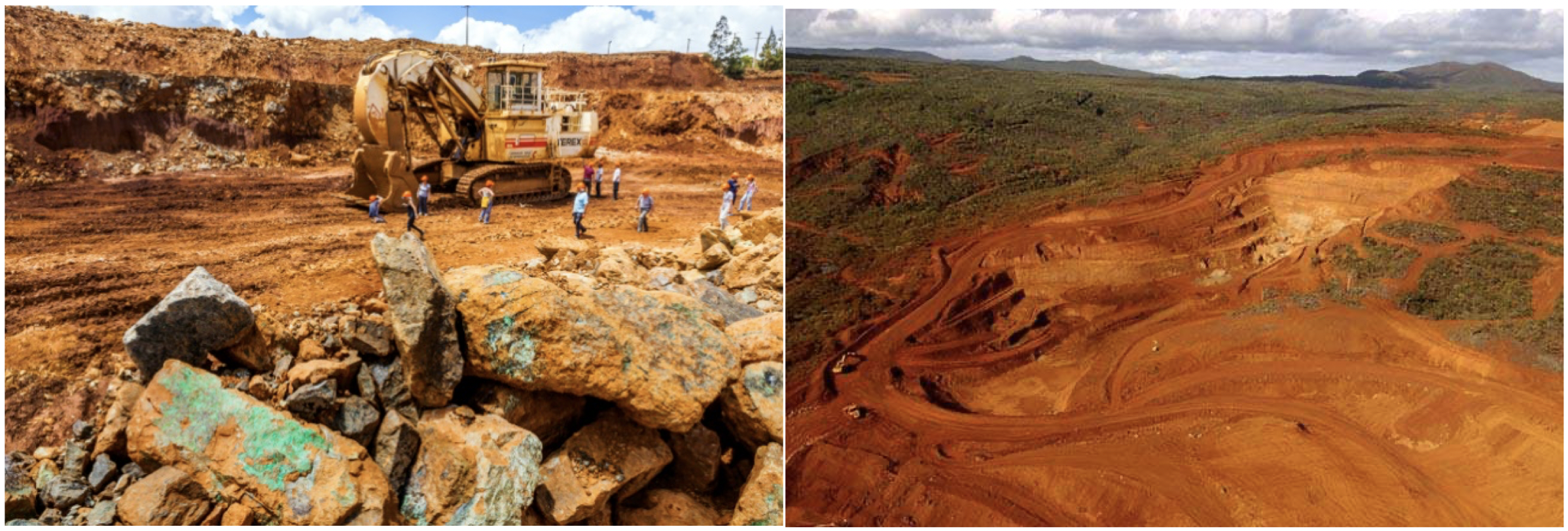
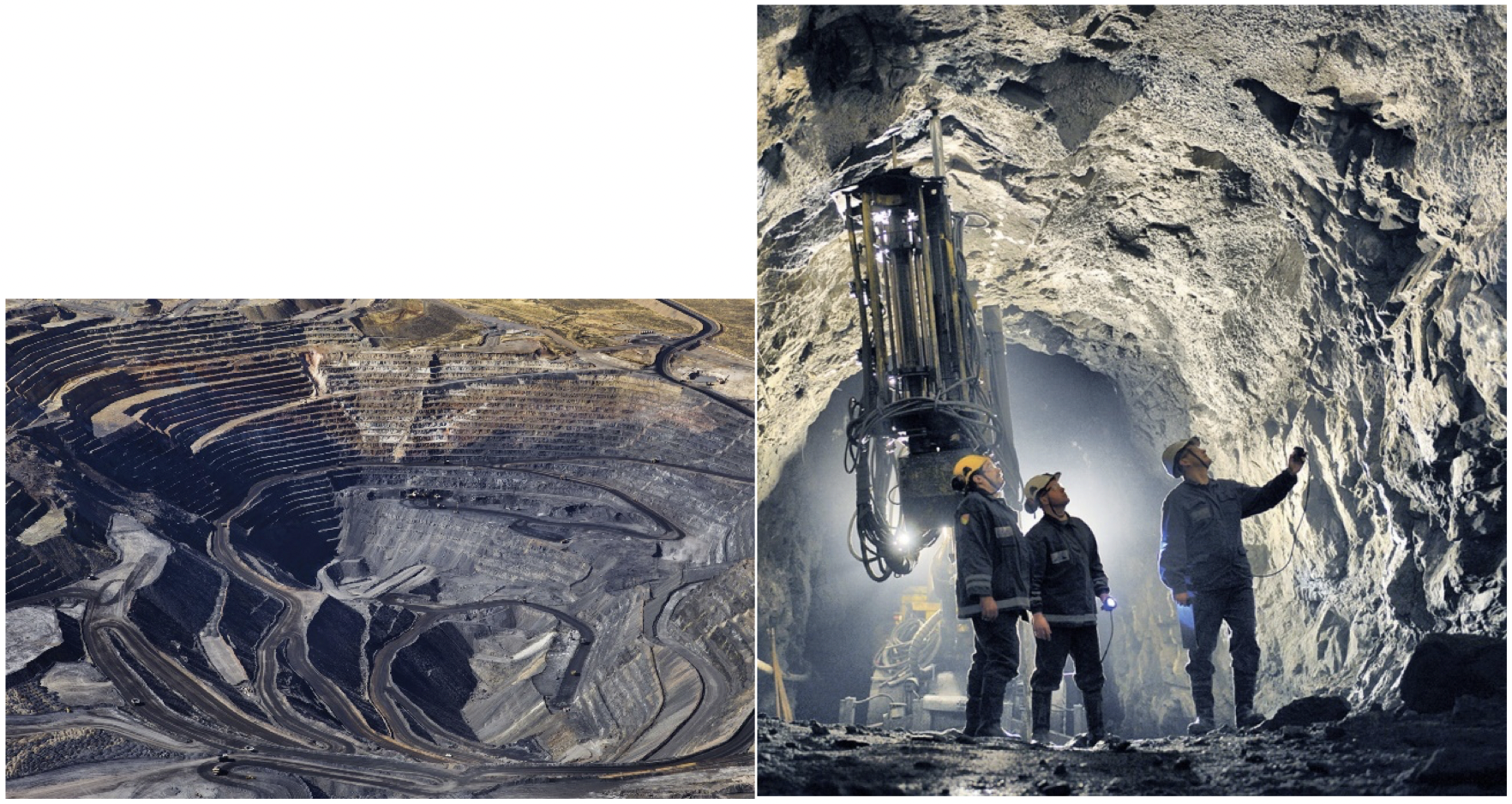
The common chemical forms of nickel are carbonate (nickel, carbon, and oxygen, NiCO3), chloride (nickel and chlorine, NiCl2), divalent oxide (nickel and oxygen, NiO), and nickel sulfate (nickel, sulfur, and oxygen, NiSO4). Nickel sulfate is a key ingredient for cathode precursors for lithium-ion batteries. Batteries for EVs utilize high-purity nickel (more than 99%) and are typically termed “Class 1.” Some stainless steel products, which comprise the largest existing use of nickel, can be made utilizing less pure, “Class 2” metal. Because nickel quality tends to be higher in sulfides, processing tends to be cheaper, creating an expensive-to-mine but cheaper-to-process proposition relative to laterite occurrences. However, lateritic deposits are more common and accessible. Our report incorporates an emerging strategy of upgrading nickel pig iron (NPI), a relatively new product obtained from laterites for steel production, to supply battery-grade material. Thus, global extraction and use of nickel going forward will entail distinct trade-offs between the costs of mining and processing and the purity for different applications. These also bear attendant and distinct environmental trade-offs. In all, the future will likely involve competition between established uses of nickel, such as for stainless steel, and new ones like batteries. On the supply side, expanding reliance on low-grade nickel resources for existing uses, and testing strategies to deploy expensive upgrading to reach higher purity levels for batteries, will dictate market dynamics going forward.
The main body of our report consists of three parts, briefly summarized below:
Electrification Ambitions—Part I
The expansive EV supply chains involved—from materials extraction to end use in vehicles and ultimate end of life—and their associated logistics are global, linking together a slew of producers and suppliers with their own, often disparate, agendas. Each node in these supply chains is accountable to the complex geopolitical realities that frame their commercial maneuverability, resulting in diverse contexts that often create conflict and misalignment. Thus, the chances of supply instability are great for the future of EVs, and opportunities for actors to extort strategic dependability come at a premium. Clearly, if every government pursues intense strategic competition for supply chain security, the risks of instability, disruption, and attendant consequences could spiral out of control.
In Part I we provide a survey of EV and EV battery (EVB) manufacturing and China’s large presence in this field. Expectations for electrification of transport are high, driving strategies and planning that have implications for nickel and other battery metals. EV sales have been assertive but remain a very small portion of global passenger vehicle purchases (less than 8%) and an even smaller share of the global fleet (less than 1%). China represents the larger of both—more than half of 2021 global EV sales occurred in China, which is now the world’s largest auto market. China’s overt strategy and aggressive tactics to be the leading developer of electric transport options mean they control nearly 100% of overall battery manufacturing and, as best we can tell, have overt control of nickel-rich chemistries. Chinese control of minerals and mining capacity, including outbound investments, has evolved accordingly. But this also means that China’s manufacturers and government overseers are exposed to any shortcomings in raw materials supply chains, just as other market participants and countries are.
Nickel Mining and Processing Backdrop—Part II
In Part II we provide details on nickel mining and processing. Investment in nickel production, as with anything, is driven by price and, more importantly, expectations about price. Rapid rises in the price of nickel and other key commodities since mid-2019 have garnered much attention, due to a combination of supply-demand imbalances and excitement about batteries and EV news. Announcements during 2021 of Chinese investments in Indonesia briefly pushed down the price of traded nickel. Releases from China’s deep commodity stockpile were an overt attempt to stabilize prices and raw materials costs for manufacturers. Both actions—China’s stockpile releases and Chinese investment activity—reflect anticipated supply-demand imbalances.
Against the backdrop of increasing demand are realities in mining and minerals processing. Ore concentrations (the amount of mineral captured per ton of material extracted) decline as prime properties reach maturity. Unless greenfield exploration can yield better opportunities, low-tier, high-cost reserves will come into inventory. Both are contingent upon commodity price. The situation for nickel is no different. Conditions like these can exacerbate large swings in price. The need for high-purity nickel to support efforts like the rapid expansion of EV output adds to market complexity and dynamics.
The Chinese Resource Play in Indonesia—Part III
Our Part III case study focuses on the growing Chinese presence in Indonesian nickel extraction and processing capabilities. China exemplifies strategic planning with an intense focus on supply chains and logistics, while Indonesia could play a strong role in breaking bottlenecks in battery-grade nickel supply, along with other Class 1 nickel end uses. Because of the importance of EVs in decarbonization strategies around the globe, Chinese control of critical upstream production and further expansion toward end-use production carries strong implications for geopolitical leverage. What could become a momentous energy and economic transition this century will be partially dependent on emerging, resource-rich economies like Indonesia that have a penchant for geopolitical and regulatory volatility. The importance of strategic positioning in these countries cannot be understated.
In short, important dynamics have emerged, with some worth noting in our introduction and others relegated to the discussion to follow. Indonesia is attractive to Chinese investment for several reasons. Most obvious, besides their geographic proximity, is the sheer abundance of nickel under Indonesian soil. Indonesia constitutes about one-third of global nickel production and a quarter of reserves—but again, quality matters. While Indonesia’s resources do not constitute traditional battery-grade nickel feedstocks, Chinese investors are not afraid to push the envelope in their operations, attempting to consolidate battery-grade and lower-purity nickel feedstocks. Chinese companies with a decades-long historical presence in the Indonesian nickel mining ecosystem are situated to negotiate and, in some cases, influence the same erratic regulations that instill reluctance among investors from other countries. Through Beijing’s support of their investments, Chinese firms in Indonesia enjoy inordinate protection from forces that prove detrimental to their competitors.
In the scheme of Indonesia’s push for higher, value-added, nickel-based cathode production, Chinese presence, especially their capital and scaled operations, presents a jumping-off point for a burgeoning slice of Indonesian exports. Chinese capital also offsets many of the barriers facing Indonesian companies’ growth in mining, processing, and battery-related businesses. For Indonesian officials, a sustainable balance is necessary: Their attempts to impose value-added, strategic industrial development for their local economy and industry could clash with China’s already lopsided geopolitical leverage.
Along with these considerations are Indonesia’s legal and regulatory regimes for mining and minerals processing—i.e., the country’s “commercial frameworks” and how inviting they are for new and/or expanded investment. A slew of environmental issues surrounds mining, particularly laterite upgrading for battery-grade nickel. Debate is lively as to whether external pressures, in particular those being placed on battery supply chain customers, and internal governance can converge to satisfy ever-expanding sustainability criteria. Regional geopolitics—always testy—will add uncertainty to the picture.
Conclusions
Clearly, neither effective public policy nor corporate strategies as they relate to minerals and materials supply chains can be devised without full and proper understanding of occurrences, operations, logistics, and locational context.
Many factors can, and will, impinge on nickel supply-demand balances, including the activities of key players, Indonesia-China interactions, and geopolitical relations. The pace and timing of energy transition technologies, the success of related strategies, and the associated government policies are all important sources of risk and uncertainty. The availability of alternative sources of Class 1 quality nickel (such as seabed nodules), the use of substitutes (such as plastics for nickel steel in appliances), and the amount of nickel recovered through recycling (more than 80% is recovered from consumer products and steel scrap) all affect future supply-demand balances.
From our case study and supporting analysis, it is becoming increasingly clear that China has positioned itself as a gatekeeper to the energy transition, with broad implications for strategic planning in the United States.
Table 1 — Case Study Summary—Risk Assessment
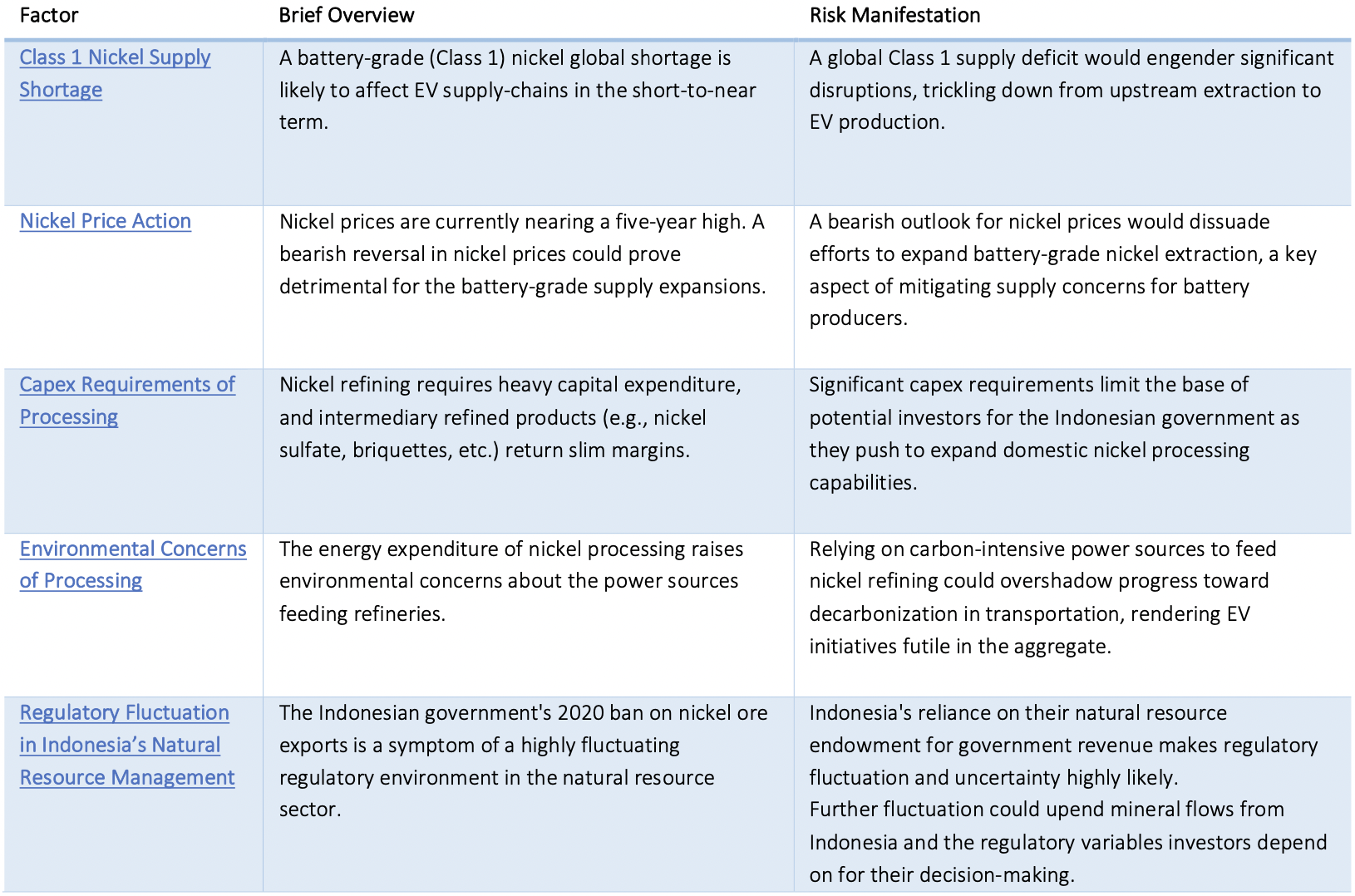
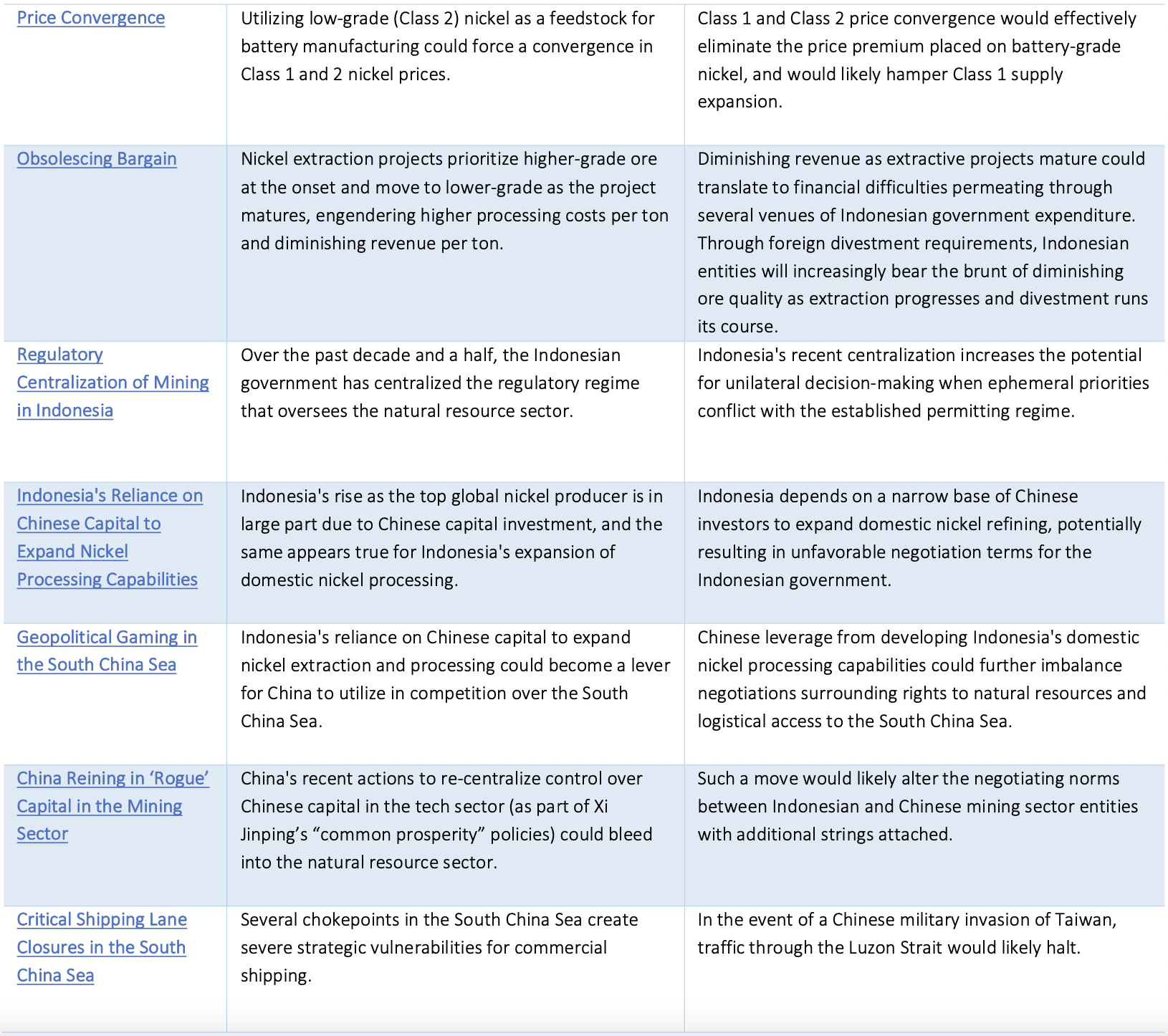
This material may be quoted or reproduced without prior permission, provided appropriate credit is given to the author and Rice University’s Baker Institute for Public Policy. The views expressed herein are those of the individual author(s), and do not necessarily represent the views of Rice University’s Baker Institute for Public Policy.


